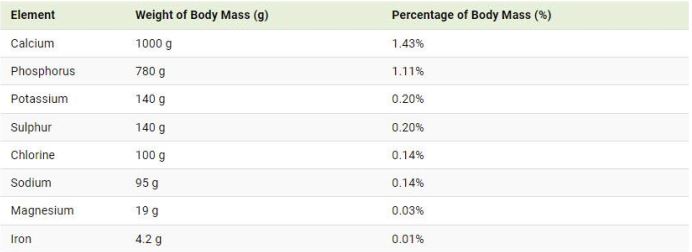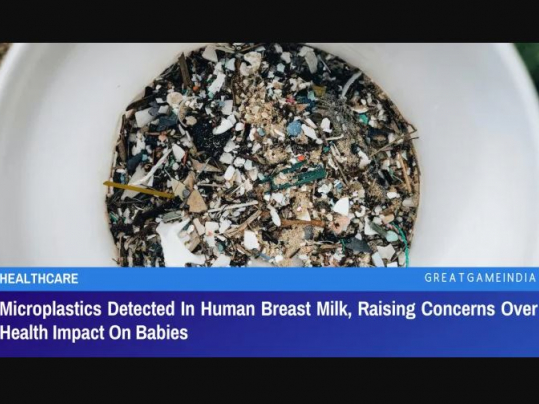Which Elements Make Up The Human Body

The International Commission on Radiological Protection has provided data which shows the elements that make up the human body and the percentage they constitute.
The human body is an incredible, well-functioning, and extremely complicated machine. For a person to be healthy, many various components must work together, and every biological detail in our bodies, from the most basic to the most complicated, is controlled by just 21 chemical elements.
Only 21 of the 118 elements on Earth are found in the human body. Together, they comprise the collection of different molecules that come together to form our DNA, cells, tissues, and organs, as explained in more depth below.
In the infographic above, we’ve broken down a human body into its elemental composition and the percentages in which they occur based on data provided by the International Commission on Radiological Protection (ICRP).
According to the amounts present in a human body, these 21 elements may be divided into three major groups: the primary building block (4 elements), essential minerals (8 elements), and trace elements (9 elements).
The Elemental Four: Ingredients for Life
The four elements oxygen, carbon, hydrogen, and nitrogen are regarded as the most vital ones in human bodies.
The most abundant element in a person’s body, oxygen makes up about 61 percent of their mass. It should come as no surprise that oxygen and hydrogen are two of the most common chemical components in the body given that between 60 and 70 percent of it is water. These elements, along with carbon and nitrogen, account for 96% of the body’s bulk.
Here is a breakdown of the four components that make up life:
Values are for an average human body weighing 70 kg.
Let’s examine how each of these four chemical elements helps to maintain the healthy functioning of our body:
Oxygen
Oxygen plays a critical role in the body’s metabolism, respiration, and cellular oxygenation. Oxygen is also found in every significant organic molecule in the body, including proteins, carbohydrates, fats, and nucleic acids. It is a substantial component of everything from our cells and blood to our cerebral and spinal fluid.
Carbon
Carbon is the most crucial structural element and the reason we are known as carbon-based life forms. It is the basic building block required to form proteins, carbohydrates, and fats. Breaking carbon bonds in carbohydrates and proteins is our primary energy source.
Hydrogen
Hydrogen, the most abundantly found chemical element in the universe, is present in all bodily fluids, allowing the toxins and waste to be transported and eliminated. With the help of hydrogen, joints in our body remain lubricated and able to perform their functions. Hydrogen is also said to have anti-inflammatory and antioxidant properties, helping improve muscle function.
Nitrogen
An essential component of amino acids used to build peptides and proteins is nitrogen. It is also an integral component of the nucleic acids DNA and RNA, the chemical backbone of our genetic information and genealogy.
Essential and Supplemental Minerals
Your body needs essential minerals to stay healthy. Your body utilizes minerals for a variety of functions, including maintaining strong bones, muscles, heart, and brain. The generation of healthy enzymes and hormones is also regulated by minerals.
Our bones are mostly made of minerals like calcium, which are necessary for both muscle contractions and bone growth and development. Phosphorus is essential for metabolizing energy and helps maintain bone and tooth strength.
Here is a glance at the elements that make up the minerals that are essential:
Values are for an average human body weighing 70 kg.
Other macro-minerals including magnesium, potassium, iron, and sodium are vital for thyroid and bone health as well as cell-to-cell communications like electric transmissions that produce nerve impulses or heart rhythms.
Any of these minerals that are too deficient might lead to a variety of health problems in your body. The majority of people consume these minerals through their regular diet, which also includes fruits, vegetables, meat, and legumes. But these elements are also prescribed as supplements in cases of deficiency.
Biological Composition of Trace Elements
Small amounts of minerals called trace elements or trace metals are present in living tissues. While some of them are proven to be nutritionally essential, others can be viewed as nonessential. They typically only make up a small part (pdf below) of our body’s mass, around 1% of it.
Trace elements like zinc, copper, manganese, and fluorine are essential among them. By acting as a first line of defense against infections, zinc increases infection resistance while regulating the immune response.
The distribution of trace elements in our body is seen here:
Values are for an average human body weighing 70 kg.
Despite only being present in trace amounts, copper is essential for the formation of red blood cells and the sustain healthy nerve cells. Additionally, it aids in the formation of collagen, an essential component of bones and connective tissue.
Scientists and researchers are continually making new discoveries despite the ongoing research and studies undertaken to fully comprehend the applications and advantages of these trace elements.
For instance, current research suggests that some of these trace elements may be utilized to treat and combat chronic and crippling diseases including cancer, cardiovascular disease, and hypertension as well as ischemia.
- Source : GreatGameIndia





















